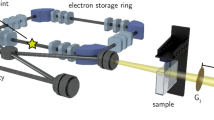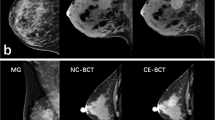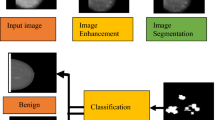Abstract
Mammography has been the mainstay of breast imaging for over four decades and is the only screening modality demonstrated to reduce mortality from breast cancer. The known limitations of mammography have prompted the development of newer imaging techniques with three-dimensional capabilities such as dedicated breast computed tomography (bCT). Several studies have shown the superiority of bCT in detection of breast masses, when compared to 2-D mammography. Malignant micro-calcification lesions can be detected and characterized by bCT. With further development of higher resolution detectors, bCT should become a modality for large population screening. Contrast-enhanced bCT (CE-bCT) adds improved specificity over mammography and may be utilized as an imaging biomarker in the emerging era of precision medicine.

Similar content being viewed by others
References
Papers of particular interest, published recently, have been highlighted as: • Of importance
Tabár L, Vitak B, Chen TH-H, et al. Swedish two-county trial: impact of mammographic screening on breast cancer mortality during 3 decades. Radiology. 2011;260(3):658–63.
Smith RA, Duffy SW, Gabe R, Tabar L, Yen AMF, Chen THH. The randomized trials of breast cancer screening: what have we learned? Radiol Clin N Am. 2004;42(5):793–806.
Mandelson MT, Oestreicher N, Porter PL, et al. Breast density as a predictor of mammographic detection: comparison of interval- and screen-detected cancers. J Natl Cancer Inst. 2000;92(13):1081–7.
Rosenberg RD, Yankaskas BC, Abraham LA, et al. Performance benchmarks for screening mammography. Radiology. 2006;241(1):55–66.
van Luijt PA, Fracheboud J, Heijnsdijk EA, den Heeten GJ, de Koning HJ, National Evaluation Team for Breast Cancer Screening in Netherlands Study G. Nation-wide data on screening performance during the transition to digital mammography: observations in 6 million screens. Eur J Cancer. 2013;49(16):3517–25.
Feig S. Cost-effectiveness of mammography, MRI, and ultrasonography for breast cancer screening. Radiol Clin N Am. 2010;48(5):879–91.
Chubak J, Boudreau DM, Fishman PA, Elmore JG. Cost of breast-related care in the year following false positive screening mammograms. Med Care. 2010;48(9):815–20.
Saslow D, Boetes C, Burke W, et al. American Cancer Society guidelines for breast screening with MRI as an adjunct to mammography. CA Cancer J Clin. 2007;57(2):75–89.
Aminololama-Shakeri S, Khatri VP. Emerging modalities in breast cancer imaging. Surg Oncol Clin N Am. 2014;23(4):735–49.
Skaane P, Bandos AI, Gullien R, et al. Comparison of digital mammography alone and digital mammography plus tomosynthesis in a population-based screening program. Radiology. 2013;267(1):47–56.
Ciatto S, Houssami N, Bernardi D, et al. Integration of 3D digital mammography with tomosynthesis for population breast-cancer screening (STORM): a prospective comparison study. Lancet Oncol. 2013;14(7):583–9.
Friedewald SM, Rafferty EA, Rose SL, et al. Breast cancer screening using tomosynthesis in combination with digital mammography. JAMA. 2014;311(24):2499–507.
Lindfors KK, Boone JM, Nelson TR, Yang K, Kwan AL, Miller DF. Dedicated breast CT: initial clinical experience. Radiology. 2008;246(3):725–33.
O’Connell AM, Karellas A, Vedantham S. The potential role of dedicated 3D breast CT as a diagnostic tool: review and early clinical examples. Breast J. 2014;20(6):592–605.
Prionas ND, Lindfors KK, Ray S, et al. Contrast-enhanced dedicated breast CT: initial clinical experience 1. Radiology. 2010;256(3):714–23.
Chang CH, Sibala JL, Fritz SL, Gallagher JH, Dwyer 3rd SJ, Templeton AW. Computed tomographic evaluation of the breast. AJR Am J Roentgenol. 1978;131(3):459–64.
Ning R, Conover D, Yu Y, et al. A novel cone beam breast CT scanner: system evaluation. Medical Imaging: International Society for Optics and Photonics, 2007; p. 651030–9.
Sarno A, Mettivier G, Russo P. Dedicated breast computed tomography: basic aspects. Med Phys. 2015;42(6):2786–804.
O’Connell A, Conover DL, Zhang Y, et al. Cone-beam CT for breast imaging: radiation dose, breast coverage, and image quality. AJR Am J Roentgenol. 2010;195(2):496–509.
Boone JM, Nelson TR, Lindfors KK, Seibert JA. Dedicated breast CT: radiation dose and image quality evaluation. Radiology. 2001;221(3):657–67.
Boone JM, Kwan AL, Seibert JA, Shah N, Lindfors KK, Nelson TR. Technique factors and their relationship to radiation dose in pendant geometry breast CT. Med Phys. 2005;32(12):3767–76.
O’Connell AM, Kawakyu-O’Connor D. Dedicated cone-beam breast computed tomography and diagnostic mammography: comparison of radiation dose, patient comfort, and qualitative review of imaging findings in BI-RADS 4 and 5 lesions. J Clin Imaging Sci. 2012;2:7.
• Kuzmiak CM, Cole EB, Zeng D, Tuttle LA, Steed D, Pisano ED. Dedicated three-dimensional breast computed tomography: lesion characteristic perception by radiologists. J Clin Imaging Sci. 2016;6:14. Reader study of comparing breast CT and digital mammography in assessing reader confidence when characterizing twenty-four BI-RADS 4 and 5 lesions.
• Zhao B, Zhang X, Cai W, Conover D, Ning R. Cone beam breast CT with multiplanar and three dimensional visualization in differentiating breast masses compared with mammography. Eur J Radiol. 2015;84(1):48–53. A comparison study of breast CT and digital mammography evaluating 85 breast masses showing improvement in performance if CT over mammography.
Chang CH, Sibala JL, Gallagher JH, et al. Computed tomography of the breast. A preliminary report. Radiology. 1977;124(3):827–9.
• Aminololama-Shakeri S, Abbey CK, Gazi P, et al. Differentiation of ductal carcinoma in-situ from benign micro-calcifications by dedicated breast computed tomography. Eur J Radiol. 2016;85(1):297–303. Reader study showing improved CT performance in differentiating benign and malignant micro-calcifications when compared to mammography.
Sardanelli F, Calabrese M, Zandrino F, et al. Dynamic helical CT of breast tumors. J Comput Assist Tomogr. 1998;22(3):398–407.
Inoue M, Sano T, Watai R, et al. Dynamic multidetector CT of breast tumors: diagnostic features and comparison with conventional techniques. AJR Am J Roentgenol. 2003;181(3):679–86.
Aminololama-Shakeri S, Prionas ND, Lindfors KK, Boone JM. Detection of DCIS with dedicated breast CT. Annual RSNA Meeting 2011.
Vedantham S, O’Connell AM, Shi L, Karellas A, Huston AJ, Skinner KA, et al. Dedicated breast CT: feasibility for monitoring neoadjuvant chemotherapy treatment. J Clin Imaging Sci. 2014;4:64.
Aminololama-Shakeri S, Nosratieh A, Lindfors KK, Boone JM. Is contrast-enhanced dedicated breast CT superior to DBTor DM in the evaluation of BIRADS 4 and 5 breast lesions? Annual RSNA Meeting. Chicago, IL; 2013.
Zuley ML, Sumkin JH, Ganott MA, et al. Comparison of contrast-enhanced cone beam CT to CE-MRI in the categorization of breast lesions. Annual RSNA Meeting. Chicao, IL; 2011.
Chen L, Abbey CK, Nosratieh A, Lindfors KK, Boone JM. Anatomical complexity in breast parenchyma and its implications for optimal breast imaging strategies. Med Phys. 2012;39(3):1435–41.
Abbey CK, Nosrateih A, Sohl-Dickstein J, Yang K, Boone JM. Non-Gaussian statistical properties of breast images. Med Phys. 2012;39(11):7121–30.
Author information
Authors and Affiliations
Corresponding author
Ethics declarations
Conflict of Interest
Shadi Aminololama-Shakeri reports grants from the National Institute of Biomedical Imaging Bioengineering and from the National Institutes of Health (NIH).
Jonathan B. Hargreaves declares that he has no conflict of interest.
John M. Boone reports grants from the National Institutes of Health (NIH), the other from Isotropic Imaging, outside the submitted work, has a patent breast CT licensed, and a patent breast CT/beam shaping filter pending.
Karen K. Lindfors reports grants from the National Institute of Biomedical Imaging Bioengineering and from the National Institutes of Health (NIH).
Human and Animal Rights and Informed Consent
This article does not contain any studies with human or animal subjects performed by any of the authors.
Additional information
This article is part of the Topical Collection on Screening and Imaging
Rights and permissions
About this article
Cite this article
Aminololama-Shakeri, S., Hargreaves, J.B., Boone, J.M. et al. Dedicated Breast CT: Screening Technique of the Future. Curr Breast Cancer Rep 8, 242–247 (2016). https://doi.org/10.1007/s12609-016-0227-2
Published:
Issue Date:
DOI: https://doi.org/10.1007/s12609-016-0227-2




